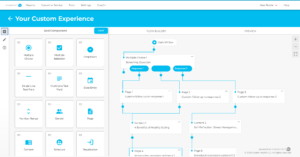Traditional on-site employee health and wellness programs create barriers to change. Here’s how to fix it.
Remote and hybrid work models, at least in some industries, are here for good. Employers and workers now asking what comes next for workplace health and wellness offerings?
For workplaces that have made the hybrid work model permanent, in-person fitness classes and employee wellness programs have often been eliminated as well. And while some employee programs moved into the virtual world, new barriers to health and wellness have been created.
So, is there a way to overcome these newfound hurdles to better health? The short answer is yes. In this blog, we’ll explore the importance of maintaining health and wellness programs for remote and hybrid employees, and how they produce positive results for companies and individuals alike.
Employer sponsored wellness programs can be a first line of defense
With employees holding on to the new liberties offered by remote and hybrid work models, companies are turning to digital/hybrid wellness and coaching options aimed at helping individuals maintain healthy habits and make lasting, impactful lifestyle changes. Such programs can provide a critical lifeline for workers.
An employee’s health and wellness can impact every aspect of their life, and not just the personal elements and their relationships. If an employee is struggling with inactivity, poor diet, stress, inadequate sleep, addictions, as well as any associated health risks such as depression and anxiety, their work, productivity, attendance and even company morale can be negatively impacted. In fact, according to a recent survey, the pandemic has intensified substance use among employees. More than one-third of workers struggling with addiction said their work has been impacted more since the pandemic began.
By providing wellness solutions that work for an increasingly virtual workforce, say in the form of digital and human coaching programs, employers can effectively engage their employees to make lasting change.
Mix of coaching programs can support health and wellness initiatives
Several unhealthy habits happen to be at the root of most chronic diseases. With many workers likely struggling with multiple issues at the same time, it’s important for companies to offer programs with the ability to prioritize care and meet each employee where they are in terms of their personal care needs.
For example, not every employee who smokes cigarettes needs to immediately start with a tobacco cessation program. Some workers may need to focus on reducing stress while others want to improve their sleep before they are ready to tackle kicking their tobacco habits. This is where many programs struggle to attract, engage, and produce real outcomes for employees. It’s because they take a one-size-fits-all approach to health and wellness, when in fact true success is realized with personalized care.
Personalization is critical to building a strong foundation that propels an employee’s momentum to change their unhealthy behaviors. When it comes to health and wellness, a mix of individualized and digital coaching can enable employees to get what they need, when they need it, how they need it.
By offering employees personalized health and wellness experiences, companies can effectively engage workers and drive employee satisfaction all while raising the likelihood of their successfully completing programs that will achieve improved health outcomes with lasting power.
Health and wellness programs lead to a reduction in overall expenditures
Did you know there are eight risks and unhealthy behaviors that account for some 80% of total costs for chronic conditions? Poor diet and stress management, excessive alcohol consumption, smoking, poor standard of care, insufficient sleep, and lack of health screening drive several chronic conditions including cancer, diabetes, obesity, asthma, congestive heart failure, lung and kidney diseases, among others.
Take smoking for example. In 2019, some 14% of American adults smoked cigarettes. According to the Centers for Disease Control and Prevention, smoking-related illness in the U.S. costs over $300 billion each year, including nearly $170 billion for direct adult medical care and $156 billion in lost productivity.
Data signals that most chronic conditions, as well as the immense healthcare and productivity costs they can incur, are preventable. The key: helping workers eliminate unhealthy behaviors. Reducing risks and unhealthy behaviors ultimately comes down to individual employees. However, employer-sponsored programs aimed at curbing lifestyle risks can provide the support they need to make a change.
Moreover, enhanced wellness programs and health coaching can lower many costs for employers and employees alike. Employees who take steps to improve their general health, complete treatment protocols, and make healthier choices are less likely to miss work and require expensive medical interventions. On the other hand, those who take proactive steps to eliminate unhealthy behaviors and manage their chronic conditions will require less healthcare resources in the long term to help address recurring health issues.
With the pandemic giving rise to sustained remote and hybrid work conditions, exacerbating substance use, and creating new barriers to traditional workplace-sponsored health and wellness programs, it’s up to employers to foster opportunities for their employees to create and maintain healthy habits.




 By spring, we launched a completely overhauled digital coaching platform,
By spring, we launched a completely overhauled digital coaching platform,  We’ve long recognized the huge gaps in care relating to the treatment of substance use disorders (SUDs), especially related to
We’ve long recognized the huge gaps in care relating to the treatment of substance use disorders (SUDs), especially related to  While many clients utilize our core coaching and content exclusively, there has been increasing demand for the ability to edit, or even create from scratch, courses and interactive experiences. We officially launched our new Content Design Studio, a “no-code” drag-and-drop flow builder enabling the simple creation of new coaching and educational experiences.
While many clients utilize our core coaching and content exclusively, there has been increasing demand for the ability to edit, or even create from scratch, courses and interactive experiences. We officially launched our new Content Design Studio, a “no-code” drag-and-drop flow builder enabling the simple creation of new coaching and educational experiences.  This fall, we released our highly anticipated Microlearning Courses, the newest behavior change tool in our arsenal that offers bite-sized learning and support for those now ready to take the all-important first step.
This fall, we released our highly anticipated Microlearning Courses, the newest behavior change tool in our arsenal that offers bite-sized learning and support for those now ready to take the all-important first step. We were accepted
We were accepted In November, we were proud and honored to be
In November, we were proud and honored to be 